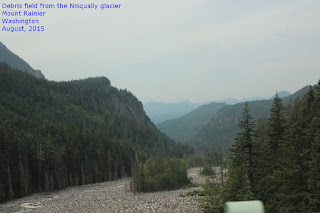We found it hard to believe, but this
place was worse than the last - we actually thought it was closed
down when we arrived. The hookups were ancient, the restrooms
marginal, the sites uneven, and an old, caved-in dump station in
between sites. The good thing – Rainier and St. Helens were close
by!
Our first day in the area, we took a
drive that took us through the little town of Ashford where we
stopped at the Copper Creek Inn for a wonderful breakfast, then on to
Mount Rainier. What a place! Huge trees, beautiful overlooks,
 and an amazing view from the visitor center of the peak of the mountain and some of its 25 glaciers. We saw our first hoary marmot – a strange color combination of the usual reddish-brown (but only on the back half) and black and gray (on the front) and the coat seems longer than the yellow-bellied marmots we've seen before. All-in-all, we spent about 10 hours driving and gawking and having a wonderful time.
and an amazing view from the visitor center of the peak of the mountain and some of its 25 glaciers. We saw our first hoary marmot – a strange color combination of the usual reddish-brown (but only on the back half) and black and gray (on the front) and the coat seems longer than the yellow-bellied marmots we've seen before. All-in-all, we spent about 10 hours driving and gawking and having a wonderful time.
The next day was just as amazing but very different in emotions – we visited Mount St. Helens. There were wildfires burning in northern Washington and we were getting ash blowing in on us from them – a bit eerie, given that we were reading about the amount of ash from the eruption here in 1980 which scorched 230 square miles of forest. The rusted, crushed car belonged
to Donald and Natalie Parker, who along with their nephew Rick drove
in, parked, and hiked another mile to their small cabin at their
copper mine claim. Eight and one-half miles from the mountain, the
area was open to those conducting
business under permit if a
liability waiver was signed. Three days later, Mt. St. Helens
unleashed a 300 mile per hour lateral blast of searing gas, ash, and
rock which took their lives. Their battered car remains, a reminder
of the 57 people who perished and the unpredictability of volcanoes.
Just a few feet away from the car, wildflowers bloomed.
The road to the viewing area was very
narrow and full of potholes and patches. Even at the 10 mph limit it
was bumpy and (for me) a bit scary, but the drive was well worth it.
The next time we are up this way, I'd like to camp on the other side
of the mountain and visit the Johnston Ridge Observatory and learn
more about volcanoes and earthquakes.
We spent the next day in Packwood,
recuperating
from two ten-hour days of intense sightseeing. We had a
very good lunch at a place just down the street from our campground
and as we got back to camp, there were elk wandering through.
Apparently, it was an every day walk, since we saw them the next
afternoon we were in camp. We noticed a neighbor was having a problem
with his motor home and Rich went over to see if he could help. It
was a flat tire and Rich was able to help. Even better, the man's
wife had put up some blackberry jam and gave us a jar. Marvelous!
We had planned to take another drive to the Sunrise Visitor Center, northeast of the summit of Rainier, then then south to the Grove of the Patriarchs but the day was overcast, with fog and intermittent rain, so we deleted the Sunrise portion of the trip, since that was about a four hour drive on narrow roads with steep drop-offs, and took a quick hike around the patriarchs, some of these huge trees are over 1,000 years old. The weather was miserable the entire day, but deep in the forest, the trees kept us mostly dry.


















































